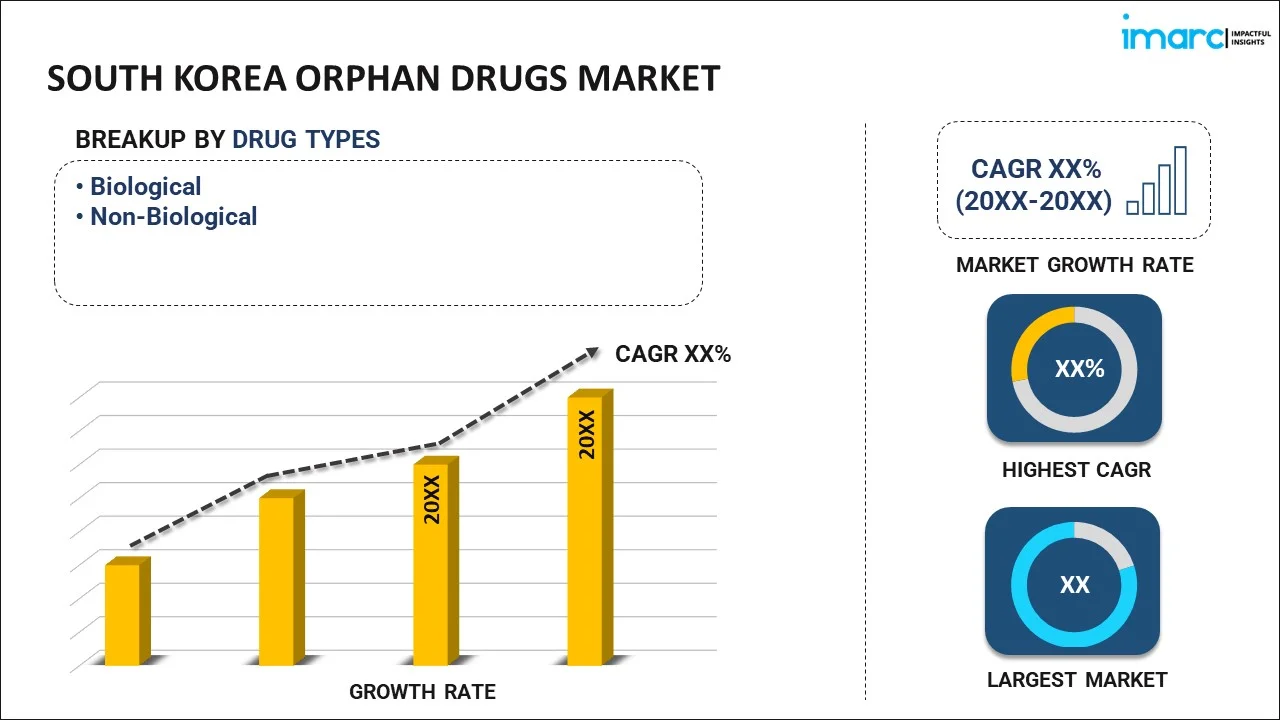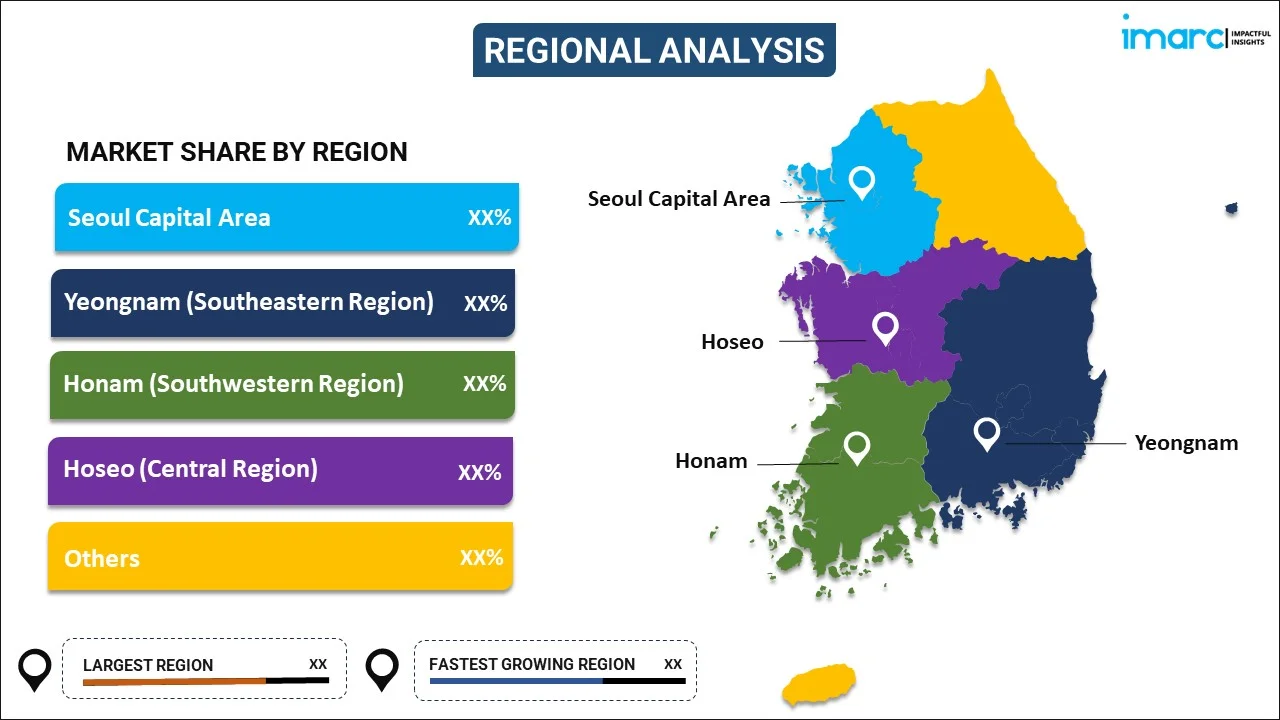
South Korea Orphan Drugs Market Report by Drug Type (Biological, Non-Biological), Disease Type (Oncology, Hematology, Neurology, Cardiovascular, and Others), Phase (Phase I, Phase II, Phase III, Phase IV), Top Selling Drugs (Revlimid, Rituxan, Copaxone, Opdivo, Keytruda, Imbruvica, Avonex, Sensipar, Soliris, and Others), Distribution Channel (Hospital Pharmacies, Retail Pharmacies, Online Stores, and Others), and Region 2025-2033
Market Overview:
South Korea orphan drugs market size reached USD 4.5 Billion in 2024. Looking forward, IMARC Group expects the market to reach USD 11.0 Billion by 2033, exhibiting a growth rate (CAGR) of 10.40% during 2025-2033. The launch of favorable policies by government bodies to inhibit the spread of contagious diseases is primarily driving the regional market.
|
Report Attribute
|
Key Statistics
|
|---|---|
|
Base Year
|
2024 |
|
Forecast Years
|
2025-2033 |
|
Historical Years
|
2019-2024
|
| Market Size in 2024 | USD 4.5 Billion |
| Market Forecast in 2033 | USD 11.0 Billion |
| Market Growth Rate (2025-2033) | 10.40% |
Orphan drugs are pharmaceutical products designed for the diagnosis, prevention, and treatment of rare medical disorders. These drugs are specifically developed to address a particular public health need and typically have a limited market due to their production for a small patient population. They prove effective against a range of conditions, including oncological, metabolic, hematologic, immunologic, infectious, and neurological diseases. Conditions such as lymphoma, leukemia, cystic fibrosis, glioma, pancreatic cancer, ovarian cancer, multiple myeloma, and renal cell carcinoma fall under the category of orphan drug applications. These medical conditions are often characterized by being life-threatening, chronic, progressive, degenerative, and disabling, necessitating tailored treatment options that are effective in addressing their unique symptoms.
South Korea Orphan Drugs Market Trends:
The South Korea orphan drugs market has emerged as a critical component within the nation's healthcare landscape, addressing the specific medical needs of individuals affected by rare disorders. The regional market offers effective solutions against a spectrum of medical conditions, encompassing oncological, metabolic, hematologic, immunologic, infectious, and neurological diseases. Additionally, conditions, such as lymphoma, leukemia, cystic fibrosis, glioma, pancreatic cancer, ovarian cancer, multiple myeloma, and renal cell carcinoma fall under the ambit of orphan drug applications. Moreover, these medical disorders often present life-threatening, chronic, progressive, degenerative, and disabling characteristics, necessitating specialized treatment alternatives that can effectively address their distinctive symptoms. Besides this, as South Korea continues to advance in healthcare innovation, the orphan drugs market becomes integral in providing targeted and efficacious solutions for patients facing rare medical challenges. The focus on precision medicine and tailored treatments aligns with the nation's commitment to delivering advanced healthcare solutions. The South Korea stands as a pivotal player in the provision of specialized therapies that enhance the quality of life for individuals grappling with rare disorders, which is expected to fuel the regional market in the coming years.
South Korea Orphan Drugs Market Segmentation:
IMARC Group provides an analysis of the key trends in each segment of the market, along with forecasts at the country level for 2025-2033. Our report has categorized the market based on drug type, disease type, phase, top selling drugs, and distribution channel.
Drug Type Insights:

- Biological
- Non-Biological
The report has provided a detailed breakup and analysis of the market based on the drug type. This includes biological and non-biological.
Disease Type Insights:
- Oncology
- Hematology
- Neurology
- Cardiovascular
- Others
A detailed breakup and analysis of the market based on the disease type have also been provided in the report. This includes oncology, hematology, neurology, cardiovascular, and others.
Phase Insights:
- Phase I
- Phase II
- Phase III
- Phase IV
The report has provided a detailed breakup and analysis of the market based on the phase. This includes phase I, phase II, phase III, and phase IV.
Top Selling Drugs Insights:
- Revlimid
- Rituxan
- Copaxone
- Opdivo
- Keytruda
- Imbruvica
- Avonex
- Sensipar
- Soliris
- Others
A detailed breakup and analysis of the market based on the top selling drugs have also been provided in the report. This includes revlimid, rituxan, copaxone, opdivo, keytruda, imbruvica, avonex, sensipar, soliris, and others.
Distribution Channel Insights:
- Hospital Pharmacies
- Retail Pharmacies
- Online Stores
- Others
The report has provided a detailed breakup and analysis of the market based on the distribution channel. This includes hospital pharmacies, retail pharmacies, online stores, and others.
Regional Insights:

- Seoul Capital Area
- Yeongam (Southeastern Region)
- Honam (Southwestern Region)
- Hoseo (Central Region)
- Others
The report has also provided a comprehensive analysis of all the major regional markets, which include Seoul Capital Area, Yeongam (Southeastern Region), Honam (Southwestern Region), Hoseo (Central Region), and Others.
Competitive Landscape:
The market research report has also provided a comprehensive analysis of the competitive landscape in the market. Competitive analysis such as market structure, key player positioning, top winning strategies, competitive dashboard, and company evaluation quadrant has been covered in the report. Also, detailed profiles of all major companies have been provided.
South Korea Orphan Drugs Market Report Coverage:
| Report Features | Details |
|---|---|
| Base Year of the Analysis | 2024 |
| Historical Period | 2019-2024 |
| Forecast Period | 2025-2033 |
| Units | Billion USD |
| Scope of the Report | Exploration of Historical Trends and Market Outlook, Industry Catalysts and Challenges, Segment-Wise Historical and Future Market Assessment:
|
| Drug Types Covered | Biological, Non-Biological |
| Disease Types Covered | Oncology, Hematology, Neurology, Cardiovascular, Others |
| Phases Covered | Phase I, Phase II, Phase III, Phase IV |
| Top Selling Drugs Covered | Revlimid, Rituxan, Copaxone, Opdivo, Keytruda, Imbruvica, Avonex, Sensipar, Soliris, Others |
| Distribution Channels Covered | Hospital Pharmacies, Retail Pharmacies, Online Stores, Others |
| Regions Covered | Seoul Capital Area, Yeongnam (Southeastern Region), Honam (Southwestern Region), Hoseo (Central Region), Others |
| Customization Scope | 10% Free Customization |
| Post-Sale Analyst Support | 10-12 Weeks |
| Delivery Format | PDF and Excel through Email (We can also provide the editable version of the report in PPT/Word format on special request) |
Key Questions Answered in This Report:
- How has the South Korea orphan drugs market performed so far and how will it perform in the coming years?
- What has been the impact of COVID-19 on the South Korea orphan drugs market?
- What is the breakup of the South Korea orphan drugs market on the basis of drug type?
- What is the breakup of the South Korea orphan drugs market on the basis of disease type?
- What is the breakup of the South Korea orphan drugs market on the basis of phase?
- What is the breakup of the South Korea orphan drugs market on the basis of top selling drugs?
- What is the breakup of the South Korea orphan drugs market on the basis of distribution channel?
- What are the various stages in the value chain of the South Korea orphan drugs market?
- What are the key driving factors and challenges in the South Korea orphan drugs?
- What is the structure of the South Korea orphan drugs market and who are the key players?
- What is the degree of competition in the South Korea orphan drugs market?
Key Benefits for Stakeholders:
- IMARC’s industry report offers a comprehensive quantitative analysis of various market segments, historical and current market trends, market forecasts, and dynamics of the South Korea orphan drugs market from 2019-2033.
- The research report provides the latest information on the market drivers, challenges, and opportunities in the South Korea orphan drugs market.
- Porter's five forces analysis assist stakeholders in assessing the impact of new entrants, competitive rivalry, supplier power, buyer power, and the threat of substitution. It helps stakeholders to analyze the level of competition within the South Korea orphan drugs industry and its attractiveness.
- Competitive landscape allows stakeholders to understand their competitive environment and provides an insight into the current positions of key players in the market.
Need more help?
- Speak to our experienced analysts for insights on the current market scenarios.
- Include additional segments and countries to customize the report as per your requirement.
- Gain an unparalleled competitive advantage in your domain by understanding how to utilize the report and positively impacting your operations and revenue.
- For further assistance, please connect with our analysts.
 Request Customization
Request Customization
 Speak to an Analyst
Speak to an Analyst
 Request Brochure
Request Brochure
 Inquire Before Buying
Inquire Before Buying




.webp)




.webp)












